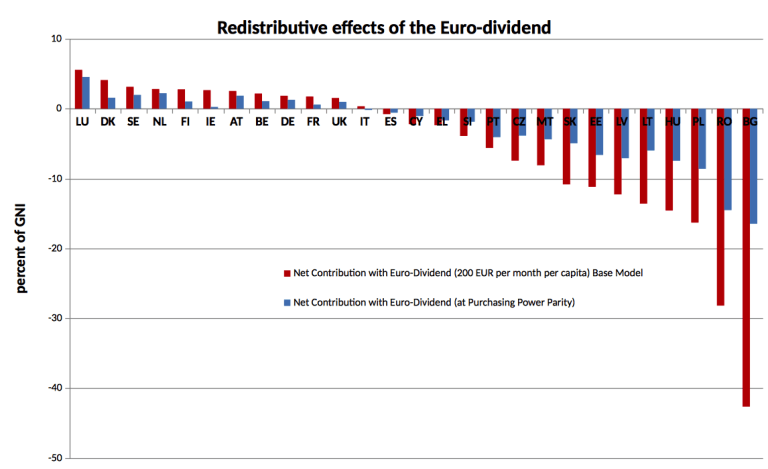Without changing the Treaties just yet, there are possible ways the EU could revive hope and support in the European integration. This requires the European Union to address the most urgent social and economic needs, relaunch citizens’ participation and prepare to fulfill its climate change commitments.
While Brexit certainly provides momentum for reforming the European Union, it remains highly uncertain whether EU leaders will make anything out of it.
Brussels is currently trying to put the European economy back on its feet by strengthening the financial and investment markets and by breaking down global trade barriers. ‘Capital Markets Union’ should make it easier to move capital around Europe, and TTIP and CETA are supposed to bring more investment and growth by increasing trade with the other side of the Atlantic. Yet neither of these initiatives are guaranteed to spur growth as both focus on wealthy investors and international corporations, making many of the EU citizens feel left out.
Transforming Europe is possible and necessary, but it will require bold policies that address the urgent needs of society and provide tangible outcomes for its citizens. Here are three proposals that, I believe, can be enacted in the upcoming few months that would be immensely valuable to the citizens of the EU, while reinforcing their support of the European Project.
Tackling extreme poverty and modernizing the welfare system by moving towards a European Basic Income
The most straightforward way the EU can win back the hearts of its citizens is by tackling the biggest problems many people face today: social and economic insecurity and the rise of poverty.
The idea of a basic income – an income distributed to all citizens regardless of their income or social conditions – would do the job. As outlined by the Belgian philosopher Philippe van Parijs, a European basic income could take the form of a ‘Eurodividend’ – a floor income to all citizens up to a modest level of around 200 euros per month.
Such a scheme would not imply the complete harmonization of welfare systems across the EU, as it is very often feared when debating the notion of social Europe. Only a partial harmonization of a fiscal system (such as VAT or corporation tax) would be necessary. This form of basic income would be the first step towards a straightforward and efficient social European model, while leaving each member state some leeway to preserve most of the specificities of their tax-benefit systems.
This is also a sound macroeconomic proposal to consolidate the Eurozone. Fiscal transfers across members states would operate as a “stabilization mechanism” for the Euro area, thereby limiting the risk of having another Greek-style crisis. Basic calculations (see below) show that the price for this solidarity move for wealthy country would remain modest (not more than 2% of Germany’s GDP) yet the effect would be massive for many poor households. Obviously, we could start with lower levels, or by limiting the scheme to children as a first step.

Across the world, Universal Basic Income is quickly emerging as the best solution to modernizing the welfare system. While this idea will be experimented in Finland next year, the EU has an opportunity to show leadership in this discussion. Admittedly though, a full-fledged eurodividend would either require treaty change or could be initiated under the enhanced cooperation procedure by voluntary countries. It’s a long-term solution.
An immediate step towards implementing basic income would be to run ten parallel local experiments across the EU to assess the impact of a basic income on the labor supply and social conditions.
Or, the European Central Bank could immediately implement something like this by using its power to create money and distribute it directly to the population. After throwing billions in the eurozone financial sector under quantitative easing, it would not be so radical for the ECB to just make a single-1,000 euro transfer directly to every Eurozone citizen, with the possibility of doing it again when necessary.
While experts think it’s legal for the ECB, it would probably require some coordination with other EU institutions and members states. Those institutions should signal their willingness to explore ways to do this, thereby encouraging the ECB to take the lead. Obviously such use of ECB’s money creation power can only be a temporary measure, yet it would allow a quick implementation of a form of basic income, until it can be sustainably financed by a sound EU fiscal system.
There seems to be a wide consensus among experts that a fiscal union for the Eurozone is necessary. Yet none of the member states are taking initiative to really make it happen, fearing loss of sovereignty and lacking national support for it. Only when the benefits of a fiscal union are clearly seen by all Europeans, there will be popular support for it. Something like a euro-dividend has the potential to do just that.
Allowing citizens’ participation in the EU: an urgent reform to the European Citizens’ Initiative
There is no need to argue whether the EU’s decision-making process is perceived as too distant from its constituents. The European Commission is stuck in its bureaucratic mindset while member states are busy struggling to protect their national interests at the European Council meetings instead of defending the general interest of the European citizens – just because the rule of unanimity allows them to.
As Thomas Piketty puts it, “The Council of the EU has become a machine to prevent any possibility of the emergence of democratic deliberation and majority decisions at European level.” In the meantime, the European Parliament is doing its best but remains helpless since it doesn’t have the right of initiative. What if citizens had a say in this highly inefficient institutional arrangement?
The European Citizens’ Initiative (ECI), established in 2012 was the first attempt to bring participatory democracy to the heart of the EU decision-making processes. This petition-like system allows citizens to put forward proposals to the EU Commission when they collect one million signatures from at least 7 countries.
Unfortunately, 3 years after its introduction, the evidence has shown the current design of this democratic instrument is fraught by legal and technical complications. And on top of it all, it is ignored by citizens because it is not legally binding, therefore it has no real impact on policy making.
Despite all the evidence for the need to reform the ECI and growing support from MEPs and civil society organisations, the Commission has so far refused to start any relevant reform of the ECI. It is long overdue, the reform must start now, and thereby send a strong signal to its citizens that they will be heard.
Besides improving the technical modalities of the instrument, there is a case for the ECI to improve the overall decision making process in the EU, and in particular to reinforce the European Parliament’s role. Why not grant a special right of initiative to the EU Parliament in case one million citizens urge it to do so? Admittedly this would require treaty change, but in the meantime, the Commission could morally commit itself to give priority to Parliament’s motions and initiative reports when they follow these European Citizens’ Initiatives. Citizens would have a truly effective instrument to channel their frustrations in a constructive way. The European Parliament would also benefit from it, as ECIs would eventually allow action to be taken in areas where the Commission has the exclusive lead.
Tackling Climate Change with an ambitious green transition plan
In Paris last year, all EU members states committed to act on mitigating climate change. Yet we still cannot see any concrete plans on how to solve this huge challenge.
Investing in green energy or renovating all public government buildings to minimize their energy consumption is a matter of several hundred billion euros. Banks are currently not inclined to finance such a programme because of the low returns on those investments. Therefore it falls onto the public institutions to show leadership and commitment. And since climate is a global issue, member states cannot act alone. The EU is therefore probably the best place to lead and coordinate the effort.
A green transition plan must be quickly enacted at the European level. It could take the form of a Juncker Plan 2.0, whereby the EU would finally start issuing eurobonds through the European Stability Mechanism and provide cheap loans to governments and regions to carry out essential public investments.
Even better, the EU could make use of its European Investment Bank (and their national equivalents) and tap the European Central Bank’s money printing scheme (Quantitative Easing) to finance those investments at no cost for the taxpayers as a MEP Molly Scott Cato has put forward. This is possible right now if only the relevant stakeholders (the ECB, the Commission, the EIB and member states) started coordinating their already existing efforts to amplify their impact.
Additionally, the EU should deliver a complete revamp of its Common Agricultural Policy (AP). While in the past the CAP has driven Europe forward by accompanying a transition towards a more efficient agricultural system, today it has become the subject of an intense struggle between the various vested interest of the agro-industrial players, with little improvement on the quality of our food production. Modernizing the CAP would therefore be an important symbolic plan which would make a positive impact on the citizens. We should aim to redistribute the subsidies from the big industrial players to smaller productions units that are less reliant on intensive polluting techniques and are more labor-intensive.
Recent research by a French Nicolas Hulot Foundation suggests such a plan could amount to 300bn euros per year for the next ten years. Such an investment is not just necessary for the environment, it would stimulate the economy to a much greater extent that anything that the EU has done so far. It would also modernized one of its most emblematic policy – the CAP – finally providing answers to its recurring critics.
By adopting such a strategy, the EU would finally prove that the EU can create jobs, and it would undeniably show commitment and forward-looking economic ambition.
A People’s European Parliament in Strasbourg
Those are just the first ideas from a potentially very long list of transformative yet pragmatic ways to reform the European Project. Many other proposals could be added to the list, but many of them would ultimately require changing the treaties – a taboo among EU policymakers.
The EU cannot afford to wait for everyone to agree on a treaty change to reform itself. This is why we need concrete, pragmatic proposals on the short term, while a medium term roadmap for revamping the two principal treaties should be announced as soon as possible.
To this matter, the European Council and the European Parliament should show their willingness to organise a new European People’s Convention (the Commission would have no choice but to take notice or it would be dismissed).
This convention would be given 12 months to write a new European Treaty. Unlike Giscard’s convention in 2001, this new convention should include greater participation from citizens. This could be done with a first round of local Citizen’s Assemblies where the priorities of the work should be set. The second round would involve a proper European Convention Assembly, whose 50% of the seats would be allocated to voluntary citizens selected by a lottery. The other half should include European and national MPs. Because this convention work must be given time and space, all participants would have to suspend their existing mandates and activities. Such an assembly could easily take place in the EU Parliament’s chamber in Strasbourg – it is empty most of the time anyway.
Importantly, it should be clear from the beginning that the outcome of the convention will be submitted to a popular vote, in a similar fashion as the Icelandic experiment few years ago where a referendum was held to ratify the new constitution proposed by the Citizens’ Assembly. Such referendum is a necessary condition for the work of the Convention to be taken seriously and for the participants to feel empowered to make the best out of it.
Europe has failed since it stopped dreaming big. More political and economic integration is often being promised as the only way to bring more prosperity and solidarity in Europe. Yet we have to acknowledge that it unclear for many how this promise will concretely deliver the intended results.
While a treaty change is inevitable in the long run, we must explore all pragmatic options and be ready to take bold action when the solutions appear. The problems pressing the shoulders of Europe are not going to get lighter with time. It is becoming clearer and clearer that the citizens will need to voice their aspirations louder, and shape the future of the European Union.
Are you ready to take part?
- Author: Stanislas Jourdan, European activist, committed to rescue the EU since 2012. I organised a european citizen’s initiative for unconditional basic income and I am currently working as coordinator for the Quantitative easing for people campaign. Based in Brussels.
- First published august 7 2016 on http://www.whygofederal.eu/beyond-brexit-3-ways-reboot-europe-now/


